ishtartv.com-
warscapes.com
Carl Drott May 25, 2015
This article
is primarily based on interviews conducted in Syria and Sweden between August
2013 and January 2015. For the sake of simplicity, the term
"Syriac" is here employed to denote also those individuals or
communities identifying as Assyrians, Chaldeans, Arameans, Christian Kurds or
Christian Arabs.
In
northeastern Syria, “Christian militias” (as they are often
termed) are now battling the Islamic State alongside Kurdish forces.
However, these groups did not simply emerge spontaneously as a response to a
security threat: they are the latest incarnations of the Dawronoye
movement, which first appeared on the European and Middle Eastern political
scenes twenty years ago. While they are indeed Christian, their fight is not
primarily for their faith, but for their nation — which is neither Syria nor
Kurdistan. In their native tongue—a contemporary descendant of the Aramaic
language spoken by Jesus—they call their people Suryoye (Syriacs) and their
homeland Bethnahrin (Mesopotamia).
Remnants
of a Shattered Community
Syriacs
were among the first to adopt the Christian faith, but their religion and
culture gradually became marginalized following the Islamic conquest. Since
they lived scattered across the Middle East, most eventually adopted the Arabic
language, while a few communities, mainly residing in or near Kurdish-dominated
areas, managed to retain their own language. In areas that today form part of
Turkey, Syriacs suffered several bouts of persecution leading up to a
horrifying climax during the First World War. Although they traditionally
obeyed their rulers and kept a low political profile, Syriacs were accused of
conspiring with the Christian enemies of the Ottoman Empire. This “problem”
found its solution in a genocide that was planned by the Ottoman authorities
and carried out in collaboration with local Kurdish Muslims who could benefit
by taking over the land and belongings of their victims. Over a quarter of a
million Syriacs perished, along with Armenian and Greek Christians and Kurdish
Ezidis. Syriacs still refer to 1915 as the “year of the sword”: Seyfo.
A
heavily decimated community managed to remain in the Turabdin area, which after
the dissolution of the Ottoman Empire became part of the Republic of Turkey.
Others settled instead in the Jazira area—just south of Turabdin—in what became
northeastern Syria. This fertile region, previously populated by Arabs, Kurds,
and Syriacs, now came to be dominated by the latter—at least for a few years.
North of the border, the Turkish government soon turned against the Kurds, who
were viewed as a threat to the desired unitary character of the new
nation-state. Following the suppression of Kurdish uprisings in the 1920s and
30s, large numbers of Kurds fled across the border and became the new majority
in the Jazira area.
For
several decades, the Kurds in Turkey offered little resistance to the state’s
assimilation policies and oppression. However, political mobilization took off
again in the 1970s, and in 1984 the secular, socialist, and nationalist
Kurdistan Workers’ Party (PKK) initiated an armed insurgency. The response was
brutal and indiscriminate: anyone living in a pro-PKK area could become a
target, and standard practices of Turkish security forces included torture,
extra-judicial executions, and the destruction of villages. Tens of thousands
of Kurds were also recruited to serve as armed “village guards,” and while some
joined voluntarily, often for opportunistic reasons, many others saw it as the
only way to save themselves from government reprisals. Meanwhile, the PKK
systematically targeted “local collaborators” and their families. Everyone in
southeastern Turkey now had to take sides—for or against the PKK.
During
this time, there was also an increase in attacks against the Syriacs in
Turabdin. Most notably, there was a wave of assassinations without any clearly
discernible motive, committed by “unknown perpetrators.” Many suspected that
the intention was to drive out the remaining Syriacs, and that the government
either was directly involved or had at least turned a blind eye. Since Syriacs
constitute both an ethnic and religious minority, nationalist as well as
religious extremists presumably desired their exodus, while local opportunists
might have sought to take over their property, just like in 1915. Groups
belonging to all these categories were at the time operating with impunity in
Turkey’s southeast since they agreed to fight the PKK on the government’s
behalf. Regardless of who was behind the violence, the presumably desired
effect was reached: over the course of the 1980s and 90s, nearly the entire
Syriac community in Turabdin migrated, mainly to European countries like
Germany and Sweden.
In
the late 1980s, a small group of Syriac youth gathered in Midyat, the main town
of Turabdin. As they discussed the seemingly hopeless future of their people,
they also noted that their predicament was similar to that of the Kurds: they
had no recognition as a distinct ethnic group with their own language, and they
suffered from discrimination and oppression. However, unlike the Syriacs, who
had always played the role of hapless victims, the Kurds were now fighting
back. The youth decided to join the PKK’s local support network—but eventually
got arrested. Although they were released, they concluded that they could not
continue like before—at least not in Turabdin. Paradoxically, since their main
goal was to enable Syriacs to remain in their homeland, they chose to follow
the migration stream to Europe.
Instead
of simply continuing to work for the PKK, the group now established its own
secret network, which by 1995 had grown into a disciplined organization along
revolutionary socialist lines. Those who pledged to become party cadres would
“leave everything behind” and live only for the struggle. It was hoped that
this vanguard would awaken the people and turn into a mass movement. They
called themselves Tukoso Dawronoyo Mothonoyo d’Bethnahrin, commonly translated
as the Patriotic Revolutionary Organization of Bethnahrin. Its members referred
to themselves simply as Dawronoye, which was first thought to translate as “the
revolutionaries.” In fact, the name turned out to mean “the modern,” and stuck
through later reorganizations as a general label for the movement and its
members. As it turned out, many had been waiting for them.
Jacob
and Sargon
Jacob
Mirza was born in 1964 in a village near Midyat. After five years of compulsory
Turkish schooling, his father sent him to study at the Mor Gabriel monastery,
where he remained for another four years. Although he did well in his studies,
he did not feel the calling to pursue an ecclesiastical career. Since
childhood, Jacob explains, “I could not accept injustice, regardless whether it
was I who suffered it or someone else, so I got involved in conflicts all the
time.”
On
one occasion, when Jacob was in his mid-teens, he joined a game of football
against a neighboring Muslim village. His Syriac team accused the referee, who
was from the Muslim village, of judging unfairly in its favor, and when an
argument descended into a brawl, Jacob proceeded to punch him in the face. Two
days later, the referee—now armed with a metal bar—went looking for him in
Midyat. “We fought again,” Jacob recounts. “He cursed at Jesus and the Bible,
and I replied with curses at Mohammed and the Quran. After that, all I saw was
chaos. All the Muslims came when they heard that a Christian had cursed at their
prophet. Anything could have happened, I mean, I could have been murdered right
there.”
In
the end, it was a Muslim who took Jacob inside his shop and locked the door,
thereby saving him from the mob. Two years later, in 1983, Jacob immigrated to
Sweden, where he started working as a language teacher (all children with
immigrant backgrounds have the right to “mother tongue tuition” in Swedish
schools). He became involved with political work, but found that the diaspora
nationalist movement was deeply divided. Since there had been no standardized
myth-making process of the kind that united European nation states in the
nineteenth century, different groups had wildly different ideas about the
definition, history, and character of their nation—or even what it should call
itself. The so-called “name dispute” primarily pitted those calling themselves
Syriacs against those calling themselves Assyrians, but Jacob never committed
to any of these names. For several years, he remained active in organizations
on both sides, but eventually lost faith in their ability to attain any
tangible political goals. Instead, he started meeting informally with a group
of friends to discuss what they could do. “During this time I was always
looking for something,” Jacob explains. One day, in a pizzeria owned by one of
his friends from the discussion group, his hopes were re-ignited.
“Jacob,
can I talk to you?” his friend asked in a low tone of voice. “This is secret.
There is a group that thinks just like us.”
The
year was 1994, and the secret group was Dawronoye. After meeting with one of
their representatives, who turned out to be an acquaintance from Turabdin,
Jacob was quickly drawn in, and the following year he attended a political
training camp where he took the pledge to become a party cadre. By this time,
he had left his job as a language teacher and set up a series of restaurants
and other businesses, which he now sold in order to devote himself full-time to
the struggle. After a stint as a grassroots political organizer in the
Netherlands and Germany, Jacob would move on to media work and travel
extensively to Iraq, Syria, Lebanon, and Iran.
Sargon
was born in 1972, and moved from Turkey to Sweden with his family at the age of
four. As he grew up, he experienced friction between the lifestyle and values
of his traditional family home and the surrounding society. “We who were
brought up in the 1970s and 80s suffered more or less from an identity crisis,
and with that came an inferiority complex and everything, and then you tried to
show yourself off as someone you are not,” Sargon explains.
In
his mid-teens, he started drinking, using drugs and acting out, and although he
had a talent for studies, his absences ultimately got him expelled from upper
secondary school, and he started working odd jobs. He also became involved in a
local Assyrian youth group and spent a lot of time reading about the
history of his people. However, the rival historical narratives presented by
different political factions added further to his identity crisis.
“Are
we Syriacs? Assyrians? Arameans? What the hell are we?” he asked himself.
While
he remained active in the youth group, he slid further into a criminal
lifestyle. “There was a lot of money flowing, lots of drugs, lots of girls
around me,” Sargon recounts. “I was a real tough guy.”
However,
in the summer of 1996 he decided to make a change: “I attended a camp with
Dawronoye, where I took the step to become a party cadre and leave everything
behind. I told them that I just have a month of prison time to serve first.”
Sargon
now had to make the transition from a local bad boy, commanding fear and
respect from everyone, to observing another hierarchy—one where he was no
longer at the top. “They had these difficulties with me in the beginning. It
was not so easy to tame me actually,” he says, adding with a smile, “But one
did everything for the fatherland.”
No
More Submission
Dawronoye’s
goal was not only to attain national rights, but also to bring about wider
social, political, and cultural change.
“The
ideology was revolutionary socialist,” Sargon says. “This does not just mean to
wage an armed struggle and bring down governments and things like that, but to
create a revolutionary personality. Since we had lived under Christian
traditions for too long, where submission was a must, we had to break that
pattern. No more submission, you have to start revolutionizing yourself, develop
yourself, and get educated.”
Many
of Dawronoye’s activities in Europe centered around the Seyfo issue. The
government in Turkey denied that any genocide had occurred in 1915, and Syriacs
there had always exercised self-censorship on the topic. “All Suryoye knew
about Seyfo, and you would talk about it at home, but you did not dare say
anything outwardly,” Jacob says. Even in Europe, the genocide of the
Syriacs—unlike that of the Armenians—was unknown to most people and
unrecognized by all governments. Dawronoye now tried to raise their voice
through street protests, hunger strikes, and house occupations, where they
demanded one simple thing: recognition of Seyfo.
There
was another issue, however, in which Dawronoye refused to take a stand.
“The
name dispute had torn us apart and emptied all of our strength,” Sargon says.
“Our goal was to enlighten the people that they are one and the same people,
with the same roots, homeland, everything.” In their events, they held both
Syriac and Assyrian flags, and tried to circumvent the name dispute by rallying
around the less contentious name of their homeland: Bethnahrin.
As
they set up their new movement, Dawronoye were coached by the far more
experienced revolutionaries of the PKK—something that was bound to spark
opposition within the Syriac community where anti-Kurdish sentiments ran deep.
These sentiments were based on more than historical grievances; the same
attitudes towards Christians that had enabled Kurdish participation in Seyfo
could still be found among tribal and conservative Kurds. However, Dawronoye
argued that the PKK represented a clear break with the past, since they
supported the same rights for others as they wanted for themselves, and
actively worked to change norms and structures within their own community.
“That
party will cooperate regardless of what people you belong to, because they are
fighting against the oppression that comes from the same direction against all
the groups there,” Jacob explains.
Many
took it for granted that Dawronoye simply constituted the Syriac wing of the
PKK. “The truth is we have always made our own decisions, but certainly we have
learned from the PKK, and they have helped us a good deal,” Sargon says.
One
of the ways in which Dawronoye asserted their independence was self-financing,
enabled through monthly membership fees and a yearly fundraising campaign.
Contributions from a few wealthy business owners were crucial, Sargon explains,
“We had one guy who helped the PKK before, and when he went over to us we
received one thousand German Marks every month as membership fee, and twenty
thousand German Marks every year in the campaign.” Dawronoye’s cadres
systematically mapped Syriac pizzerias and other businesses, and went
door-to-door asking for donations. “Just here in Sweden, we could collect one
or one and a half million Swedish Kronor,” Sargon says, referring to the yearly
campaign. “People believed in us, but unfortunately the church and the other
organizations said we extorted people. There was nothing like that.”
Mountain
Guerrillas
While
Europe became a stage for political activities, and Syriacs there provided
crucial funding, Dawronoye had from the start aimed to return to Bethnahrin. To
show the world that they were no longer willing to submit, members were
going to establish an armed wing and fight the Turkish state. However,
southeastern Turkey had a far too high presence of security forces and
informants, so in 1995 the first group of cadres instead travelled to Syria,
and from there crossed over into Iraq.
“Since
Turkey was in conflict with the PKK in northern Iraq we could take the conflict
there,” Jacob explains. In the eyes of Dawronoye, this was not foreign
territory, since Turkey, Syria, and Iraq all form part of Bethnahrin.
Furthermore, Jacob explains, “We thought there would be changes in the Middle
East, particularly in Iraq, and that we needed to be prepared. The conditions
were also far better. In Turabdin there were maybe four-five thousand people,
but we had about one point two million Assyrians, Syriacs, and Chaldeans in
Iraq.”
The
conditions in northern Iraq may have been favorable, but they were also very
complicated. The Kurds, who form the vast majority of the population here, had
risen up against Saddam Hussein’s oppressive government in the wake of the
1990-91 Gulf War, expecting support from the United States and its allies.
As the government moved in to crush the uprising, US and allied forces finally
intervened to establish the world’s first “no-fly zone”— which effectively became
a “no-go zone” for government forces. The Kurdistan region now gained de facto autonomy,
and when largely free and fair elections were held the following year, it
seemed like a promising sign. However, the results produced a draw between
Jalal Talabani’s Patriotic Union of Kurdistan (PUK) and Massoud Barzani’s
Kurdistan Democratic Party (KDP). A “fifty-fifty” power-sharing arrangement
failed to bring about a functional government, and tensions between the two
rivals finally came to a head in 1994, when civil war broke out. During the
conflict, the PUK allied itself with the PKK and Iran, while the KDP developed
a close cooperation with Turkey—which also sent its own troops across the
border to hunt down the PKK. Although the PUK-KDP conflict ended in 1998, the
war against the PKK continued.
Dawronoye
first established itself in the Badinan area, which lies on the Turkish
border and has a sizeable Syriac population. However, this is also KDP
heartland, and despite Dawronoye’s declaration of neutrality in the
intra-Kurdish conflicts, the group was soon forced to leave for the Qandil
mountains. Here, fighters set up a separate camp in the close vicinity of
a major PKK base, where they could receive military training, and from
1996 onwards they fought alongside their mentors. Dawronoye’s guerrillas were
so few, and at least initially so inexperienced, that they never launched
any operations on their own, but instead rotated for duty in a small unit that
was integrated into the armed wing of the PKK.
“There
was fighting maybe every week or every other week, where the unit took part. We
had at least four or five comrades all the time in the fighting,” says Sargon,
who joined the guerrillas in May 1999—only a few months before a unilateral PKK
ceasefire brought an end to Dawronoye’s war.
Although
they tried to stay out of the intra-Kurdish conflicts, Dawronoye were
inevitably dragged into the fighting between the PKK and the KDP, and on one
occasion, an attack was even launched on Dawronoye’s own initiative. A young
Syriac woman named Helen Sawa had disappeared in May 1999, and when her body
was found a month later, suspicions pointed to a senior KDP leader that had
employed her in his household. Local authorities were accused of covering up
the alleged rape and murder, and a few weeks later the PKK and Dawronoye
launched a retaliatory attack against a KDP outpost. It was more than “an eye
for an eye”– around forty KDP peshmerga were reportedly killed in the fighting.
“We felt that something had to be done, since they had acted like they did,”
says Sargon. “We wanted the world to see that we are here, we exist, and we can
take revenge too.”
The
Imagined and the Real Bethnahrin
In
2000, Dawronoye held its first congress, and members reorganized as
the Bethnahrin Freedom Party (Gabo d’Hirutho d’Bethnahrin, or GHB). Sargon
criticized the new party’s vague political vision and lack of concrete goals,
and when he refused to back down he was imprisoned in the mountain camp. “I had
to accept what the congress had decided, and unconditionally follow the party,”
says Sargon, who after several weeks buckled and went back to his duties.
The
congress also saw the first cracks emerge in the relation between Dawronoye and
the PKK, whose representatives were not invited; although their cooperation
continued, the PKK henceforth viewed its Syriac allies with open suspicion.
After
Dawronoye were forced out from the Badinan area, they had tried to
mobilize the small Syriac communities in the PUK zone, but with little success.
“The people in those areas had started calling themselves 'Christian
Kurds.' They had no concept of an own identity,” Sargon explains.
Dawronoye instead turned their focus to the larger Syriac communities residing
in Mosul and on the Nineveh plains, outside of the no-fly zone.
Since
they shared common enemies, Saddam Hussein’s government tolerated a limited
presence of PKK cadres in the nearby Makhmour refugee camp, and they would now
provide cover for Dawronoye. “I could move around in the Mosul area, but had to
be very alert, because the Mukhabarat [the intelligence service] was extremely
good at detecting people who behaved in an odd way,” says Sargon, who arrived
in Makhmour in the autumn of 2001 and remained for about a year. He and his
comrades successfully organized a network of local intelligence operatives, but
their attempts to awaken some kind of political and national consciousness in
the wider Syriac population failed. “Those who called themselves Assyrians were
nationalistic, but the Chaldeans and Syriacs just saw themselves as Christians.
They did not know any better, they did not even know that they and the
Assyrians are the same people,” Sargon says, adding another
explanation: “They thought Saddam would never fall, and you sensed the
fear in the population. The fear of the state was immense.”
Dawronoye
nevertheless managed to attract scores of new party cadres from various
locations, and over time its armed wing grew to include around one hundred
and fifty guerrillas. While a core group of around thirty-five originated from
Turkey and had lived in Europe, the rest were local recruits.
However, they rarely developed the “revolutionary character” that was
expected.
“We
did not succeed in making the guys from Iraq believe in our cause, in a better
future and all that. It was more for their own gain that they came to us, it
was not like ideological or nationalistic or anything, but they wanted food for
the day or thought we could help them get to Europe,” Sargon says. “You know,
when you talk about nation and fatherland and all of that, you have to have
common emotions, and like, we lacked those common emotions. We had an illusion
about what Bethnahrin was, while they lived in a real Bethnahrin that was only
shit, that was only oppression, hunger, and fear.”
New
Politics for a New Middle East
When
the US invasion arrived in the spring of 2003, Dawronoye joined the Kurdish
offensive from the north, hoping to assert itself as a political force in the
newly liberated areas. “Together with the PUK, we went into Kirkuk and took
some offices belonging to the Baath party,” Sargon recounts. The Iraqi army had
fled before they even arrived, and soon thereafter Dawronoye decided to
demobilize their armed wing and end their cooperation with the PKK.
“We
thought new politics would begin in the Middle East, and that we would be able
to fight for our rights in a political way. This is why we laid down our
weapons,” explains Jacob, who left the PKK-affiliated Medya TV to set up
Dawronoye’s own Suroyo TV.
While
Dawronoye failed to establish any real foothold in post-invasion Iraqi
politics, another arena opened up around the same time, as Turkey appeared to
be edging closer to EU membership. In order to lobby the EU and its member
states in relation to the accession talks, Dawronoye founded the European
Syriac Union (Huyodo Suroyo d’Urifi or ESU) in 2004—but the new organization’s
more polished and diplomatic approach, along with the sudden adoption of the
term “Syriac,” proved controversial internally.
“They
changed strategy without any congress or anything. Why should we call ourselves
'Syriacs' and who decided this?” Sargon asked. He was promptly imprisoned
once again.
Although
the reforms later stalled, there were initially indications that the government
of Recep Tayyip Erdogan would set Turkey on a new path towards democracy and
pluralism. In 2005, the Syriac spring festival Akitu could, for the first time,
be organized openly in Midyat. Despite the fact that they had fought the
Turkish army only a few years earlier, and never officially concluded any peace
deal, Dawronoye was behind the well-attended celebrations. Not only did the
authorities tolerate the event, but it was even personally attended by the
Governor of Mardin Province—while Prime Minister Erdogan sent a congratulatory
message. Jacob describes it as a game from both sides:
“Turkey
wanted to take us under its control, and we wanted to test how Turkey reacts.”
For Sargon, however, this was no victory, but the final proof that Dawronoye
had abandoned their ideals and ended the struggle prematurely, without securing
any meaningful political concessions. “You can sit with your enemy or your
oppressor, but there should not just be peace for one side, while the other
gets nothing,” he argues. “Okay, maybe some in the Dawronoye movement can
travel to Turkey without getting arrested, but what have you gained on that as
a people? Nothing.” After nine years as a full-time party cadre, six of which
were spent in Iraq, Sargon finally cut all ties with Dawronoye and returned to
Sweden.
The
Changing Game in Syria
Dawronoye
had maintained a presence in Syria from the very beginning, primarily in the
Jazira area, and although the regime's intelligence agencies occasionally
clamped down on the movement, they mostly stuck to monitoring its activities
through regular meetings. Open agitation against the government was clearly a
red line, but cultural activities as well as political work relating to Turkey
and Iraq would generally be tolerated. This arrangement came to an abrupt end
in the spring of 2012, as Dawronoye’s Syrian affiliate, the Syriac Union Party
(Gabo d’Huyodo Suryoyo or SUP), used the Akitu celebrations as an opportunity
to declare its opposition to the regime of Bashar al-Assad. A few days later,
several activists were arrested in early morning raids, and more were
picked up when a demonstration organized in response was violently disbanded.
However, although several were tortured, they were ultimately released.
Apparently, regime security forces exercised more restraint here than in
other parts of the country, so as not to jeopardize existing local
support, but they would soon lose territorial control anyway.
A
few months later, the People’s Protection Units (YPG) took control of a large
part of the Jazira area and the government withdrew to a few isolated
enclaves. While the YPG stood under the control of the Democratic Union Party
(PYD), which cautiously tried to forge a third way between the government and
the rebels, activists from the SUP pushed their way into the Syrian embassy in
Stockholm, issuing a press release condemning “the terrorist regime of
Al-Assad” and hailing ”the martyrs of the Syrian Revolution.” Despite such
defiant declarations, Dawronoye could accomplish precious little on
its own, and there were few “moderate rebels” in the area—only a growing
threat from jihadist and criminal groups. However, since the PYD is the Syrian
branch of the PKK movement, the solution appeared natural. Dawronoye would get
back together with its former allies and take up arms again.
“We
did not really need to discuss or decide anything new,” says Jacob, who at the
time sat in the leadership of the Bethnahrin National Council (Mawtbo Umthoyo
d’Bethnahrin or MUB), the supreme body of the Dawronoye movement that replaced
GHB in late 2005. “We always said that we may come back to Iraq again with
weapons, or to Lebanon, to Syria.”
Some
guerrilla veterans from the 1990s were brought in from Iraq, Turkey, and
Europe, while others were already present in Syria, where they began training
local recruits. The following year, in 2013, a police force called Sutoro
opened three stations in the Jazira area, and a military force called the
Syriac Military Council (Mawtbo Fulhoyo Suryoyo or MFS) announced its existence
in an online video. The MFS initially hinted at future military action against
the regime, but this never materialized. Instead, a more immediate and
existential threat appeared, as a coalition of rebel and jihadist groups
suddenly attacked. The MFS and the YPG soon fought side-by-side in the
frontlines to defend the area, while Sutoro developed an increasingly close
cooperation with its Kurdish counterpart Asayish. Just like in the 1990s,
Dawronoye integrated into the security structures of their Kurdish allies,
while retaining their own organizations and financing themselves through
diaspora donations.
Around
the same time as the attacks began, the PYD invited other parties and civil
society organizations to participate in a process to form local governance
structures. Most turned down the offer, fearing that the PYD would continue to
dominate, but the SUP participated actively from the beginning until the end.
Among the chief declared goals was one to ensure the peaceful coexistence of
different ethnic and religious communities. With unmistaken symbolism, one of
the first meetings was conducted across the border in Midyat, where Kurdish
representatives took the opportunity to apologize for their people’s role in
Seyfo. When the autonomous “Jazira canton” was declared in January 2014, representatives
of the SUP took up positions in the government and legislative assembly, while
Syriac, Arabic, and Kurdish were declared official languages.
“We
believe that this philosophy of [the PKK leader] Ocalan can be a model not just
for the Kurds but for other peoples also,” says Nazira Goriye, the
co-spokesperson of the legislative assembly. “We want our rights not just as
Christians, but as a people, as a nation. This is why we are on the side of the
Kurds, not on Assad’s side. Assad tries to give our people a morphine
injection.”
The
Future of Bethnahrin
Over
the years, Dawronoye learned to adapt to a rapidly shifting political
environment, and several times changed its strategy to exploit
opportunities wherever they emerged. More often than not, the
group has seen its ambitions frustrated—not surprisingly,
considering that it has always tried to punch above its weight.
Perhaps Dawronoye's activists have now finally found their chance.
Dawronoye’s core goal is to ensure the future existence of its people in
their native lands, but with the possible exception of the Nineveh plains in
Iraq, there is no place where they could realistically seek regional autonomy,
let alone their own state. In other words, they have to find a way to live with
the majority population without being dominated by it. Meanwhile, the PKK
movement has come to embrace a vision of a multicultural mosaic within a
decentralized democratic system. While sharing some overarching political
structures, different communities should be encouraged to organize their own
grassroots-level structures, and manage their own affairs to the greatest
extent possible. In other words, the respective projects of Dawronoye and the
PKK coincide perfectly in Syria.
So,
what are the chances that Dawronoye can garner popular support for
its project? After all, these secular, nationalist revolutionaries
represent a complete inversion of their community’s tendency to remain
politically passive and subservient while turning to religion for consolation.
“The
Kurds are one step ahead of us, but if you look at what the Syriacs were like
before and what they are like now, I think we have made great progress,” Jacob
says. “This struggle will continue, because we have cultivated a thought among
our people that we have to fight to survive, we have to fight to be free, we
have to fight for our children’s future and not give up.”
Unlike
the PKK, Dawronoye have yet not succeeded in building a mass movement—but the
necessary infrastructure is in place, in the form of a network of affiliated
civil society organizations. Furthermore, the lawless situation in Syria plays
to their strengths. Like the PKK, Dawronoye are well organized and good at
getting things done, and their cadres are motivated by ideology rather than
material incentives. Perhaps most importantly, they are now the ones holding
arms to defend the area. In a situation where the Islamic State is directly
threatening the very survival of the Syriac people, Dawronoye and their Kurdish
allies are fighting and dying in the frontlines to protect them, asking for
nothing in return—except the opportunity to shape tomorrow’s society.
*Carl
Drott is a Swedish freelance journalist who has covered the conflict in
Syria for Le Monde diplomatique, Haaretz, Syria Comment, the Carnegie Endowment
for International Peace and the Stockholm Journal of International Affairs,
among others. For his previous piece for Warscapes - "Extremists"
and "Moderates" in Kobani - was reported from the midst of
the seige.
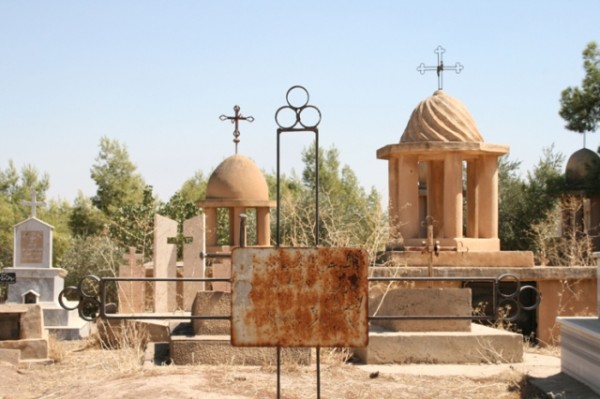
Cemetary by the Syriac Orthodox St. George s Church in the village of Mherka, northeastern Syria. (Photo ©Carl Drott, Sept. 2013)
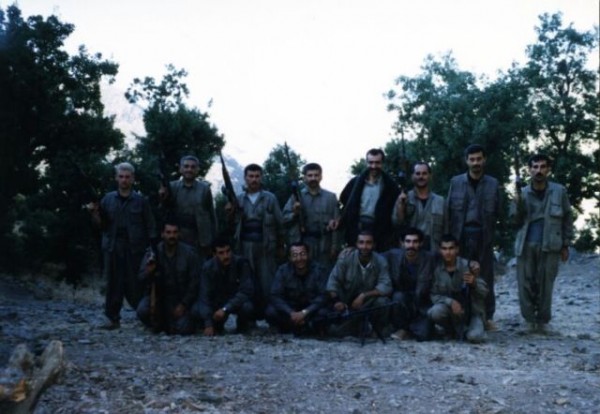
Dawronoye s television team visits the guerrillas. Beside Jacob Mirza (front row, third from left) sits Sargon Adam, holding a machine gun. (Photo courtesy Sargon Adam, August 1999)
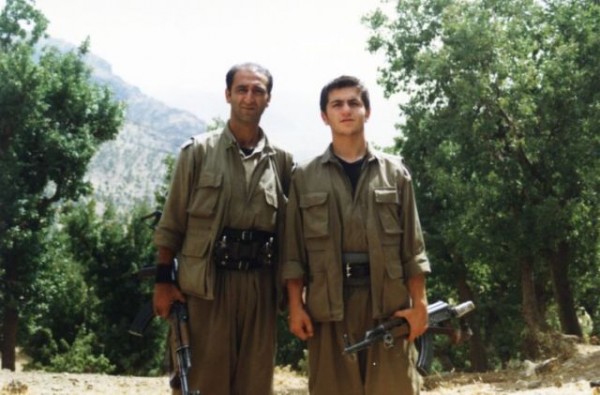
Sargon Adam (left) and his comrade, Midyat, in the mountains. (Photo courtesy Sargon Adam, July 1999)
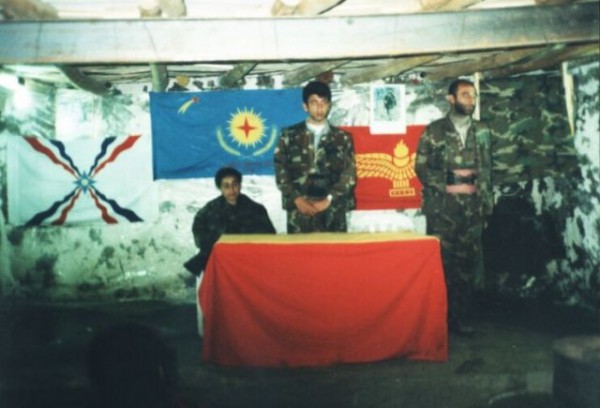
A meeting conducted shortly before Dawronoye s guerrillas engaged in military operations alongside Kurdish forces. In the background hang Assyrian, GHB and Syriac flags. (Photo courtesy Sargon Adam, March 2003)
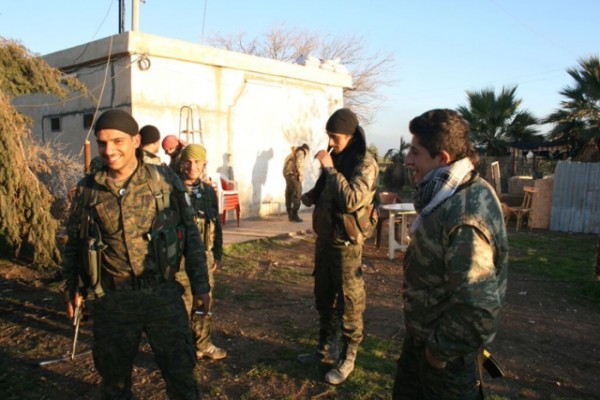
MFS fighters outside their base in Ghardukah, northeastern Syria. (Photo ©Carl Drott, January 2014)
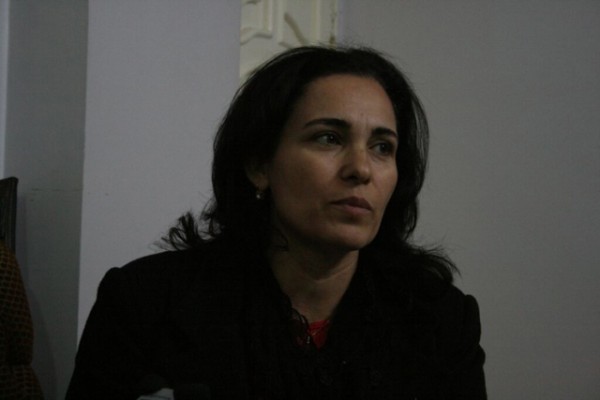
Nazira Goriye, co-spokesperson of the legislative assemply in the autonomous Jazira canton. (Photo ©Carl Drott, January 2014)
|